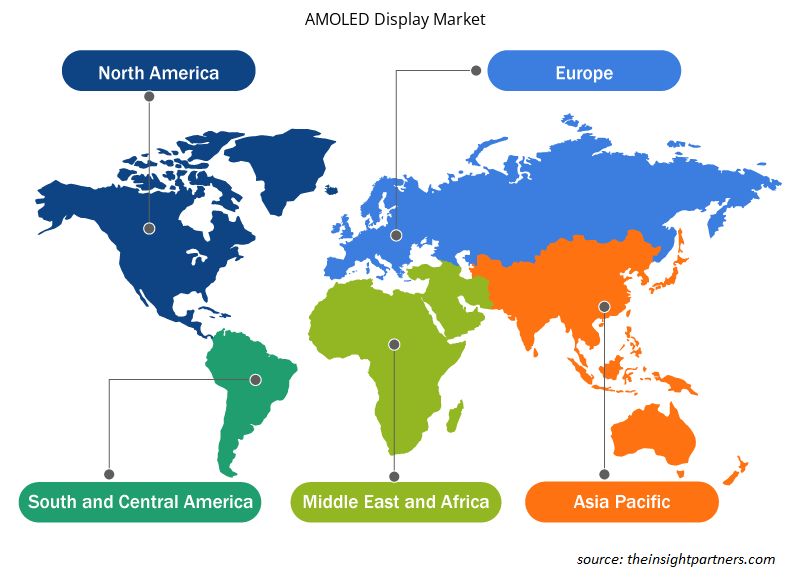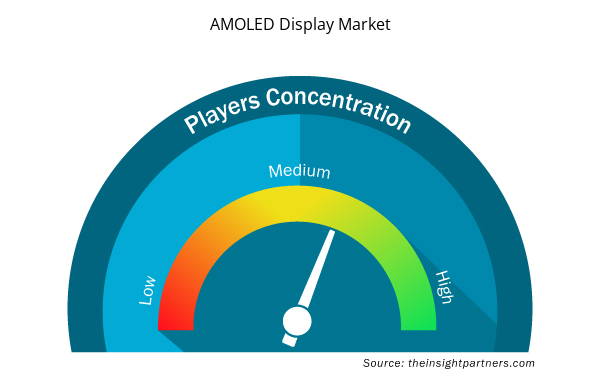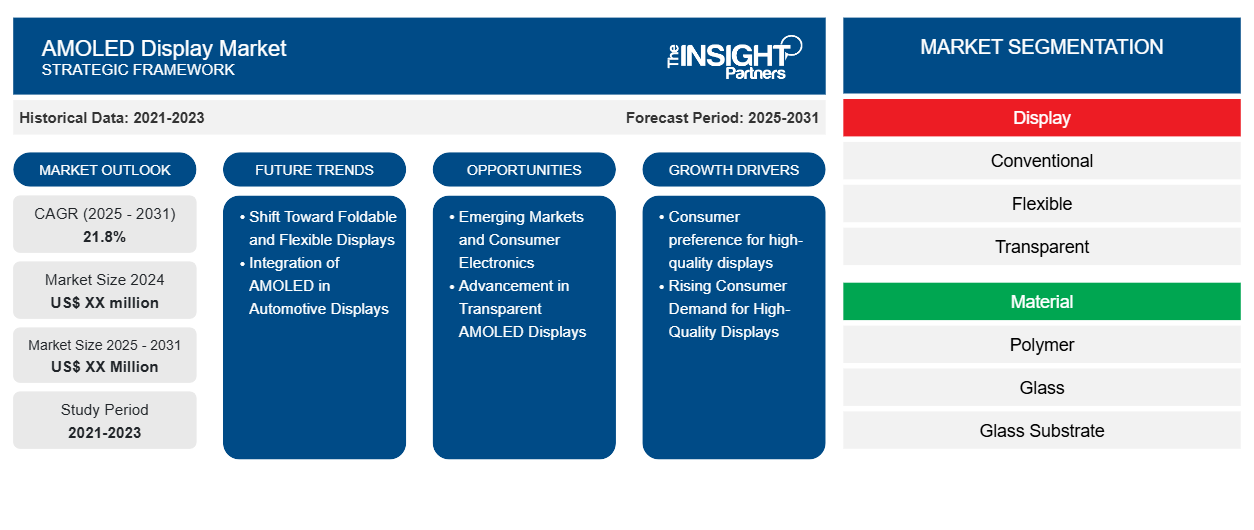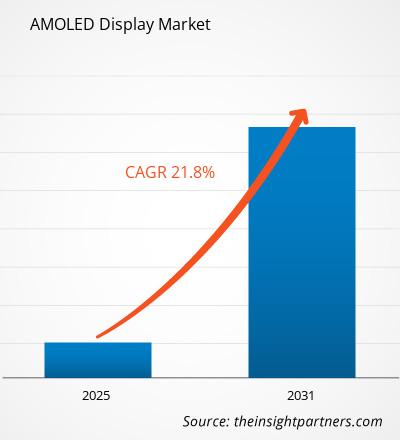Se espera que el mercado de pantallas AMOLED registre una CAGR del 21,8 % entre 2024 y 2031, con un tamaño de mercado que se expandirá de US$ XX millones en 2024 a US$ XX millones en 2031.
El informe está segmentado por pantalla (convencional, flexible, transparente, 3D), material (polímero, vidrio, sustrato de vidrio), aplicación (electrónica de consumo, venta minorista, automoción, atención médica, otros). El análisis global se desglosa aún más a nivel regional y por países principales. El informe ofrece el valor en USD para el análisis y los segmentos anteriores.
Propósito del Informe
El informe AMOLED Display Market de The Insight Partners tiene como objetivo describir el panorama actual y el crecimiento futuro, los principales factores impulsores, los desafíos y las oportunidades. Esto proporcionará información a diversas partes interesadas del negocio, como:
- Proveedores/fabricantes de tecnología: Para comprender la dinámica cambiante del mercado y conocer las oportunidades potenciales de crecimiento, lo que les permitirá tomar decisiones estratégicas informadas.
- Inversionistas: Realizar un análisis exhaustivo de tendencias sobre la tasa de crecimiento del mercado, las proyecciones financieras del mercado y las oportunidades que existen en toda la cadena de valor.
- Órganos reguladores: Regular las políticas y vigilar las actividades del mercado con el objetivo de minimizar los abusos, preservar la confianza de los inversores y defender la integridad y estabilidad del mercado.
Segmentación del mercado de pantallas AMOLED
Mostrar
- Convencional
- Flexible
- Transparente
- 3D
Material
- Polímero
- Vaso
- Sustrato de vidrio
Solicitud
- Electrónica de consumo
- Minorista
- Automotor
- Cuidado de la salud
- Otros
Geografía
- América del norte
- Europa
- Asia-Pacífico
- América del Sur y Central
- Oriente Medio y África
Personalice este informe según sus necesidades
Obtendrá personalización en cualquier informe, sin cargo, incluidas partes de este informe o análisis a nivel de país, paquete de datos de Excel, así como también grandes ofertas y descuentos para empresas emergentes y universidades.
- Obtenga las principales tendencias clave del mercado de este informe.Esta muestra GRATUITA incluirá análisis de datos, desde tendencias del mercado hasta estimaciones y pronósticos.
Factores impulsores del crecimiento del mercado de pantallas AMOLED
- La preferencia de los consumidores por pantallas de alta calidad: la creciente demanda de los consumidores de experiencias visuales de alta calidad es uno de los impulsores de la expansión del mercado de las pantallas AMOLED. Los consumidores cada vez más desean dispositivos con tecnología de pantalla superior que ofrezcan colores brillantes, negros más profundos y una mayor eficiencia energética, que es lo que ofrecen las pantallas AMOLED.
- Demanda creciente de pantallas de alta calidad por parte de los consumidores: los consumidores ahora priorizan las pantallas de alta resolución, vibrantes y de bajo consumo, lo que empuja a los fabricantes a adoptar la tecnología AMOLED. Las pantallas AMOLED ofrecen negros más profundos, mejores relaciones de contraste y colores más vivos en comparación con las pantallas LCD tradicionales, lo que mejora la experiencia visual en teléfonos inteligentes, televisores y tabletas. A medida que aumentan las expectativas de los consumidores de una mejor calidad visual, la demanda de pantallas AMOLED continúa aumentando en diversas aplicaciones.
Tendencias futuras del mercado de pantallas AMOLED
- El cambio hacia las pantallas plegables y flexibles: una tendencia importante en el mercado de AMOLED es el cambio hacia las pantallas plegables y flexibles. La tecnología OLED permite pantallas más delgadas y flexibles que se pueden doblar o plegar, lo que crea nuevas oportunidades para productos innovadores como teléfonos inteligentes plegables, televisores flexibles e incluso paneles de pantalla curvos en interiores de automóviles. Esta tendencia está acelerando la adopción de pantallas AMOLED, ya que permiten la próxima generación de dispositivos electrónicos flexibles.
- Integración de AMOLED en pantallas automotrices: la industria automotriz está adoptando cada vez más la tecnología AMOLED para las pantallas de los automóviles debido a su capacidad de proporcionar un alto contraste, negros profundos y una visibilidad superior en todas las condiciones de iluminación. Las pantallas AMOLED se están integrando en tableros, grupos de instrumentos y sistemas de información y entretenimiento, ofreciendo una experiencia visual de primera calidad y estéticamente agradable. Esta tendencia refleja un cambio hacia una tecnología mejorada en los automóviles y experiencias conectadas, lo que impulsa la demanda de pantallas AMOLED en aplicaciones automotrices.
Oportunidades de mercado en las pantallas AMOLED
- Mercados emergentes y productos electrónicos de consumo: a medida que mejora la asequibilidad de la tecnología AMOLED, los mercados emergentes de Asia-Pacífico, América Latina y África ofrecen un potencial de crecimiento significativo. Las empresas de productos electrónicos de consumo de estas regiones están adoptando cada vez más pantallas AMOLED en teléfonos inteligentes, televisores y otros dispositivos para competir con las marcas globales. La expansión de la clase media y el aumento de los ingresos disponibles en estas regiones están impulsando el crecimiento de los productos equipados con AMOLED.
- Avances en las pantallas AMOLED transparentes: el desarrollo de pantallas AMOLED transparentes representa una oportunidad prometedora para el mercado. Estas pantallas se pueden utilizar en una variedad de aplicaciones, como pantallas de visualización frontal (HUD) en automóviles, sistemas de realidad aumentada (RA) e incluso señalización minorista. Las pantallas AMOLED transparentes combinan una alta calidad de imagen con un diseño innovador, lo que abre nuevas posibilidades para las industrias que buscan integrar las pantallas sin problemas en entornos del mundo real.
Perspectivas regionales del mercado de pantallas AMOLED
Los analistas de Insight Partners explicaron en detalle las tendencias y los factores regionales que influyen en el mercado de pantallas AMOLED durante el período de pronóstico. Esta sección también analiza los segmentos y la geografía del mercado de pantallas AMOLED en América del Norte, Europa, Asia Pacífico, Oriente Medio y África, y América del Sur y Central.

- Obtenga datos regionales específicos para el mercado de pantallas AMOLED
Alcance del informe sobre el mercado de pantallas AMOLED
| Atributo del informe | Detalles |
|---|---|
| Tamaño del mercado en 2024 | XX millones de dólares estadounidenses |
| Tamaño del mercado en 2031 | US$ XX millones |
| Tasa de crecimiento anual compuesta (CAGR) global (2025-2031) | 21,8% |
| Datos históricos | 2021-2023 |
| Período de pronóstico | 2025-2031 |
| Segmentos cubiertos | Por pantalla
|
| Regiones y países cubiertos | América del norte
|
| Líderes del mercado y perfiles de empresas clave |
|
Densidad de actores del mercado de pantallas AMOLED: comprensión de su impacto en la dinámica empresarial
El mercado de pantallas AMOLED está creciendo rápidamente, impulsado por la creciente demanda de los usuarios finales debido a factores como la evolución de las preferencias de los consumidores, los avances tecnológicos y una mayor conciencia de los beneficios del producto. A medida que aumenta la demanda, las empresas amplían sus ofertas, innovan para satisfacer las necesidades de los consumidores y aprovechan las tendencias emergentes, lo que impulsa aún más el crecimiento del mercado.
La densidad de actores del mercado se refiere a la distribución de las empresas o firmas que operan dentro de un mercado o industria en particular. Indica cuántos competidores (actores del mercado) están presentes en un espacio de mercado determinado en relación con su tamaño o valor total de mercado.
Las principales empresas que operan en el mercado de pantallas AMOLED son:
- Compañía de pantallas LG, Ltd.
- Samsung Electronics Co., Ltd.
- Corporación AU Optronics.
- Corporación Ritek
- Grupo Tecnológico BOE Co., Ltd.
Descargo de responsabilidad : Las empresas enumeradas anteriormente no están clasificadas en ningún orden particular.

- Obtenga una descripción general de los principales actores clave del mercado de pantallas AMOLED
Puntos de venta clave
- Cobertura integral: el informe cubre exhaustivamente el análisis de productos, servicios, tipos y usuarios finales del mercado de pantallas AMOLED, proporcionando un panorama holístico.
- Análisis de expertos: el informe se compila sobre la base de un profundo conocimiento de expertos y analistas de la industria.
- Información actualizada: El informe asegura relevancia comercial debido a su cobertura de información reciente y tendencias de datos.
- Opciones de personalización: este informe se puede personalizar para satisfacer los requisitos específicos del cliente y adaptarse adecuadamente a las estrategias comerciales.
Por lo tanto, el informe de investigación sobre el mercado de pantallas AMOLED puede ayudar a abrir el camino para descifrar y comprender el escenario de la industria y las perspectivas de crecimiento. Si bien puede haber algunas preocupaciones válidas, los beneficios generales de este informe tienden a superar las desventajas.
- Análisis histórico (2 años), año base, pronóstico (7 años) con CAGR
- Análisis PEST y FODA
- Tamaño del mercado Valor/volumen: global, regional, nacional
- Industria y panorama competitivo
- Conjunto de datos de Excel


- Vertical Farming Crops Market
- Microplate Reader Market
- Water Pipeline Leak Detection System Market
- Smart Grid Sensors Market
- Green Hydrogen Market
- Ceiling Fans Market
- Mail Order Pharmacy Market
- Biopharmaceutical Contract Manufacturing Market
- Small Internal Combustion Engine Market
- Public Key Infrastructure Market

Report Coverage
Revenue forecast, Company Analysis, Industry landscape, Growth factors, and Trends

Segment Covered
This text is related
to segments covered.

Regional Scope
North America, Europe, Asia Pacific, Middle East & Africa, South & Central America

Country Scope
This text is related
to country scope.
Preguntas frecuentes
Some of the customization options available based on the request are an additional 3-5 company profiles and country-specific analysis of 3-5 countries of your choice. Customizations are to be requested/discussed before making final order confirmation# as our team would review the same and check the feasibility
The report can be delivered in PDF/PPT format; we can also share excel dataset based on the request
Consumer preference for high-quality displays and the rising adoption of AMOLED displays in consumer electronics are the major factors driving the AMOLED display market.
The shift towards flexible displays and integration with artificial intelligence is likely to remain a key trend in the market.
The AMOLED Display Market is estimated to witness a CAGR of 21.8% from 2023 to 2031
Trends and growth analysis reports related to Electronics and Semiconductor : READ MORE..
1. LG Display Co., Ltd.
2. Samsung Electronics Co., Ltd.
3. AU Optronics Corp.
4. Ritek Corporation
5. BOE Technology Group Co., Ltd.
6. China Star Optoelectronics Technology
7. Panasonic Corporation
8. Sony Corporation
9. Innolux Corporation
10. EverDisplay Optronics
The Insight Partners performs research in 4 major stages: Data Collection & Secondary Research, Primary Research, Data Analysis and Data Triangulation & Final Review.
- Data Collection and Secondary Research:
As a market research and consulting firm operating from a decade, we have published and advised several client across the globe. First step for any study will start with an assessment of currently available data and insights from existing reports. Further, historical and current market information is collected from Investor Presentations, Annual Reports, SEC Filings, etc., and other information related to company’s performance and market positioning are gathered from Paid Databases (Factiva, Hoovers, and Reuters) and various other publications available in public domain.
Several associations trade associates, technical forums, institutes, societies and organization are accessed to gain technical as well as market related insights through their publications such as research papers, blogs and press releases related to the studies are referred to get cues about the market. Further, white papers, journals, magazines, and other news articles published in last 3 years are scrutinized and analyzed to understand the current market trends.
- Primary Research:
The primarily interview analysis comprise of data obtained from industry participants interview and answers to survey questions gathered by in-house primary team.
For primary research, interviews are conducted with industry experts/CEOs/Marketing Managers/VPs/Subject Matter Experts from both demand and supply side to get a 360-degree view of the market. The primary team conducts several interviews based on the complexity of the markets to understand the various market trends and dynamics which makes research more credible and precise.
A typical research interview fulfils the following functions:
- Provides first-hand information on the market size, market trends, growth trends, competitive landscape, and outlook
- Validates and strengthens in-house secondary research findings
- Develops the analysis team’s expertise and market understanding
Primary research involves email interactions and telephone interviews for each market, category, segment, and sub-segment across geographies. The participants who typically take part in such a process include, but are not limited to:
- Industry participants: VPs, business development managers, market intelligence managers and national sales managers
- Outside experts: Valuation experts, research analysts and key opinion leaders specializing in the electronics and semiconductor industry.
Below is the breakup of our primary respondents by company, designation, and region:

Once we receive the confirmation from primary research sources or primary respondents, we finalize the base year market estimation and forecast the data as per the macroeconomic and microeconomic factors assessed during data collection.
- Data Analysis:
Once data is validated through both secondary as well as primary respondents, we finalize the market estimations by hypothesis formulation and factor analysis at regional and country level.
- Macro-Economic Factor Analysis:
We analyse macroeconomic indicators such the gross domestic product (GDP), increase in the demand for goods and services across industries, technological advancement, regional economic growth, governmental policies, the influence of COVID-19, PEST analysis, and other aspects. This analysis aids in setting benchmarks for various nations/regions and approximating market splits. Additionally, the general trend of the aforementioned components aid in determining the market's development possibilities.
- Country Level Data:
Various factors that are especially aligned to the country are taken into account to determine the market size for a certain area and country, including the presence of vendors, such as headquarters and offices, the country's GDP, demand patterns, and industry growth. To comprehend the market dynamics for the nation, a number of growth variables, inhibitors, application areas, and current market trends are researched. The aforementioned elements aid in determining the country's overall market's growth potential.
- Company Profile:
The “Table of Contents” is formulated by listing and analyzing more than 25 - 30 companies operating in the market ecosystem across geographies. However, we profile only 10 companies as a standard practice in our syndicate reports. These 10 companies comprise leading, emerging, and regional players. Nonetheless, our analysis is not restricted to the 10 listed companies, we also analyze other companies present in the market to develop a holistic view and understand the prevailing trends. The “Company Profiles” section in the report covers key facts, business description, products & services, financial information, SWOT analysis, and key developments. The financial information presented is extracted from the annual reports and official documents of the publicly listed companies. Upon collecting the information for the sections of respective companies, we verify them via various primary sources and then compile the data in respective company profiles. The company level information helps us in deriving the base number as well as in forecasting the market size.
- Developing Base Number:
Aggregation of sales statistics (2020-2022) and macro-economic factor, and other secondary and primary research insights are utilized to arrive at base number and related market shares for 2022. The data gaps are identified in this step and relevant market data is analyzed, collected from paid primary interviews or databases. On finalizing the base year market size, forecasts are developed on the basis of macro-economic, industry and market growth factors and company level analysis.
- Data Triangulation and Final Review:
The market findings and base year market size calculations are validated from supply as well as demand side. Demand side validations are based on macro-economic factor analysis and benchmarks for respective regions and countries. In case of supply side validations, revenues of major companies are estimated (in case not available) based on industry benchmark, approximate number of employees, product portfolio, and primary interviews revenues are gathered. Further revenue from target product/service segment is assessed to avoid overshooting of market statistics. In case of heavy deviations between supply and demand side values, all thes steps are repeated to achieve synchronization.
We follow an iterative model, wherein we share our research findings with Subject Matter Experts (SME’s) and Key Opinion Leaders (KOLs) until consensus view of the market is not formulated – this model negates any drastic deviation in the opinions of experts. Only validated and universally acceptable research findings are quoted in our reports.
We have important check points that we use to validate our research findings – which we call – data triangulation, where we validate the information, we generate from secondary sources with primary interviews and then we re-validate with our internal data bases and Subject matter experts. This comprehensive model enables us to deliver high quality, reliable data in shortest possible time.


 Obtenga una muestra gratuita de este informe
Obtenga una muestra gratuita de este informe